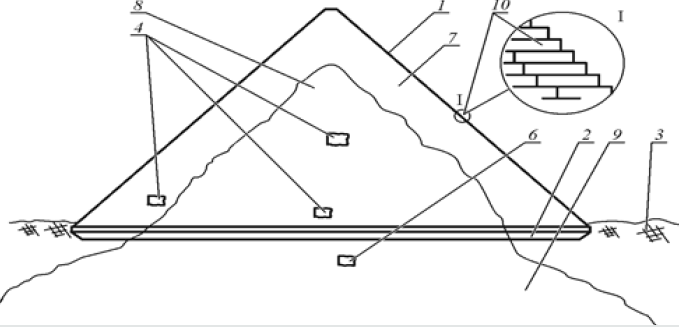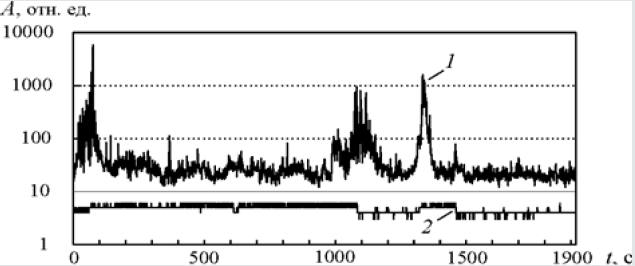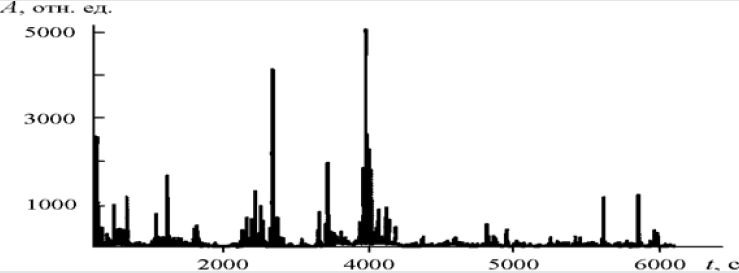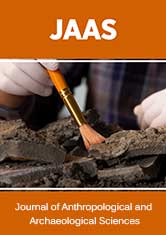
Lupine Publishers Group
Lupine Publishers
Menu
ISSN: 2690-5752
Review ArticleOpen Access 
Geophysical Fields and Signals of Some Pyramids Volume 2 - Issue 1
Oleg B Khavroshkin2*, Dmitrii G Pavlov1 and Vladislav V Tsyplakov2
- 1Firm, Antares, Russia
- 2Schmidt Institute of physics of the Earth, Russian Academy of Science, Russia
Received: March 11, 2020 Published: April 03, 2020
Corresponding author: OB Khavroshkin, Schmidt Institute of physics of the Earth, Russian Academy of Science, Russia
Abstract
- Abstract
- Preliminary Remarks
- The Used Equipment and Instruments
- Methods
- Seismic Signals and Seismic Emission Fields: Records, Preliminary Processing, Short Comments
- Registration of Seismic Emission Near the Broken (Southern) Pyramid
- Active Seismic Fields and Signals
- Comments
- Electromagnetic fields
- Variations of Tilts of Pyramids
- Radiation Background and Fluids
- Analysis of Gas Samples
- Conclusion
- References
Instruments, methods and equipment for registration of geophysical fields and signals are described. Examples of records of seismic noise, seism acoustic emission and electromagnetic emission, accompanying emission processes, as well as seismic pulses are shown. Data on tilt of pyramid (Broken, Dakhshur) and gas samples from chambers of pyramids Khufu (Giza) and Red (Dakhshur) are presented.
Preliminary Remarks
- Abstract
- Preliminary Remarks
- The Used Equipment and Instruments
- Methods
- Seismic Signals and Seismic Emission Fields: Records, Preliminary Processing, Short Comments
- Registration of Seismic Emission Near the Broken (Southern) Pyramid
- Active Seismic Fields and Signals
- Comments
- Electromagnetic fields
- Variations of Tilts of Pyramids
- Radiation Background and Fluids
- Analysis of Gas Samples
- Conclusion
- References
In accordance with the main aims of investigation (geophysical fields and signals of the most remarkable Egyptian pyramids and surrounding geological structures) the field investigations primarily had the reconnaissance character and were limited by the pyramids’ area near Memphis.
Even in the framework of routine geophysics this region is very interesting: after strong earthquakes of the early Middle Ages and continuous calm now the seismic activation is observed. The pyramid area, as well as the Greater Cairo, are inside the zone of high seismic intensity and activity of faults. Accordingly the first stage of investigation was connected with the pyramids’ area of the Giza plateau, which in fact borders upon the Greater Cairo, and the pyramids’ area in Dakhshur, which is far removed from the sources of industrial noise, as well as the pyramids in Medum [1].
The most complete cycle of the seismic investigations was conducted on the pyramid Snofru (Southern). Significant attention was paid to the investigations of non-linear seismic effects and noise, which require the special equipment and high culture of seismic experiment. Technical and methodical basis of such investigations requires the special attention, so the reader could refer to the final report [2]. During all measurements wind and industrial noise were absent, other particularities are described for each particular experiment.
The Used Equipment and Instruments
- Abstract
- Preliminary Remarks
- The Used Equipment and Instruments
- Methods
- Seismic Signals and Seismic Emission Fields: Records, Preliminary Processing, Short Comments
- Registration of Seismic Emission Near the Broken (Southern) Pyramid
- Active Seismic Fields and Signals
- Comments
- Electromagnetic fields
- Variations of Tilts of Pyramids
- Radiation Background and Fluids
- Analysis of Gas Samples
- Conclusion
- References
The following equipment was used for measurements of different geophysical fields of pyramids and surrounding structures.
The standard seismometers-velocimeters SV10 and SG10 with the frequency band of 10 to 1000 Hz, transformation coefficient of 16 V/m/sec, and non-standard seismometer NVS, which is the velocimeter with the high transformation coefficient of 160 V/m/ sec and the frequency band of 5 to 1000 Hz. Registration system for analogue signals IDL-02-04 (8 channels, dynamic range of 70 db, frequency band f = 0 - 25 Hz, solid state memory capacity - 4Mbit). Electronic unit for registration of envelope of the seismic emission (ROSE), which consists of microprocessor, two-channel recorder of digital transformer of analogue signals within the frequency band of 5 to 1000 Hz with subsequent summation and calculation of mean value for the selected time interval (sec, min). The minimal measurable signal is < 10-6 V (for displacements 10- 11 - 10-12 m for seismometer-velocimeter NVS), dynamic range is about 120 dB, duration of registration is 1 sec. System of registration IDL-02-04 for registration of high frequency signals (active impact). Dosimeter-radiometer (ANRI-01-02) with the following technical characteristics: power of gamma radiation range, mR/h - 0.010 - 9.999, energy of gamma radiation range, MeV - 0.06 - 1.25, relative error for Cs137 is less than 30%. Tiltmeter non-standard (NN), sensitivity < 1 second of arc (10-9rad). UHF ferrite antenna for registration of electromagnetic radiation (EMR) accompanying the seismo acoustic emission (SAE) [3].
Methods
- Abstract
- Preliminary Remarks
- The Used Equipment and Instruments
- Methods
- Seismic Signals and Seismic Emission Fields: Records, Preliminary Processing, Short Comments
- Registration of Seismic Emission Near the Broken (Southern) Pyramid
- Active Seismic Fields and Signals
- Comments
- Electromagnetic fields
- Variations of Tilts of Pyramids
- Radiation Background and Fluids
- Analysis of Gas Samples
- Conclusion
- References
The main object of the measurements was the seismic processes and fields, as well the seism acoustic emission. Seismometers NVS were used for registration of seismic signals and fields, such as seismic and seism acoustic emission and background noise. Recording of seismic fields was carried out by the electronic unit of the system of registration of envelope of the seismic emission (ROSE). Amplitude and energy spectra of seismic noise, recorded on the pyramid, were obtained with the use of the seismometer NVS [4].
Active impact was limited by weak shocks (excitations) on side faces of pyramids or on separate blocks for determination of velocity characteristics of materials. Method of falling weight and seismometers SG10 and CV10 were used for location of reflecting boundaries and probable hollows. Taking into account the small coefficient of transformation and low level of seismic noise only seismic signals, generated by shocks, and signals, connected with their reflection and propagation, were recorded during active experiments. Dosimeter-radiometer ANRI-01-02 «SOSNA» was used for measurement of natural radioactivity of blocks and facing plates of pyramids, and entire natural radioactive background was measured on day face. Tilt-meters were installed on plates of basement of the pyramids in center of faces, leeward, 2-3 meters from the ground surface.
Seismic Signals and Seismic Emission Fields: Records, Preliminary Processing, Short Comments
- Abstract
- Preliminary Remarks
- The Used Equipment and Instruments
- Methods
- Seismic Signals and Seismic Emission Fields: Records, Preliminary Processing, Short Comments
- Registration of Seismic Emission Near the Broken (Southern) Pyramid
- Active Seismic Fields and Signals
- Comments
- Electromagnetic fields
- Variations of Tilts of Pyramids
- Radiation Background and Fluids
- Analysis of Gas Samples
- Conclusion
- References
Seismic emission fields were recorded by ROSE equipment on pyramids Snofru in Dakhshur («Red» and «Broken») and in Medum («Wrong»), including internal chamber of the latter. Seismoacoustic emission was recorded by one channel and simultaneously signals from UHF antenna were recorded by the other one. By different reasons duration of records was varied from 20 minutes to 3-5 hours. Figure 1 Examples of records of seismic noise envelopes SAE and EMR (Figures 1-3)
Figure 3: Pyramid in General and Instruments Stays Points. 1-massif of pyramid; 2-foundation; 3-soil; 4-points for instruments stays; 6-underground point; 7-surface blocks; 8-seismic acoustic Emission pyramid massif; 9-underground emission soil massif; 10-structure of pyramid surface (increase scale).

a) The record of fluctuations of seismic emission envelope in Dakhshur on the Southern «Broken» pyramid: seismometer was installed in the center of the western face 5 meters above the ground level, and the record of envelope of the signal from the ferrite antenna. Grey curve in the seismic noise envelope, black curve is the envelope of electromagnetic emission of the pyramid body. X-axis: current time in seconds, Y-axis: amplitude of envelope in microvolts (March 3, 2004).
b) The record of fluctuations of seismic emission envelope in Dakhshur on the Southern «Broken» pyramid: seismometer was installed in the center of the western face 5 meters above the ground level, and the record of envelope of the signal from the ferrite antenna. Grey curve in the seismic noise envelope, black curve is the envelope of electromagnetic emission of the pyramid body. X-axis: current time in seconds, Y-axis: amplitude of envelope in microvolts (March 3, 2004).
c) Fragment of the record (Figure 1b) near point of origin from 220th to 280th seconds.
d) The record of fluctuations of the seismic emission envelope on pyramid in Medum: seismometer was installed in the center of the southern face (grey curve); the other cannel is the record of the envelope of the signal from ferrite antenna (black curve), March 21, 2004.
e) The record of fluctuations of the seismic emission envelope in the chamber of pyramid in Medum (grey curve) and the record of the envelope of the signal from ferrite antenna (black curve), March 21, 2004.
f) Record of envelope of variations of seismic noise and seismic emission on the top of the small pyramid near the «Broken» or Southern (figure 3) in Dakhshur on two channels: standard more low frequency seismometer (fn 2 - 5 Hz) (black curve) and non-standard high sensitive seismometer (5 - 7 times more) (grey curve), March 23, 2004.
g) Fragment of the record of noise (figure 1f), first part (250 seconds) with higher amplitude caused by seismic emission.
Registration of Seismic Emission Near the Broken (Southern) Pyramid
- Abstract
- Preliminary Remarks
- The Used Equipment and Instruments
- Methods
- Seismic Signals and Seismic Emission Fields: Records, Preliminary Processing, Short Comments
- Registration of Seismic Emission Near the Broken (Southern) Pyramid
- Active Seismic Fields and Signals
- Comments
- Electromagnetic fields
- Variations of Tilts of Pyramids
- Radiation Background and Fluids
- Analysis of Gas Samples
- Conclusion
- References
Seismic emission was investigated with use of small pyramid. Just before the equipment was turned on 3 shocks were made near the basement of the small pyramid for generation of seismic emission in near-surface structures. The effect was observed for 600 seconds (figure 1f, g).
It is necessary to notice the fact of increasing of the seismic noise on the top of the small pyramid (approximately 10 times) in comparison with the noise level near the basement (compare figures 1a, f), i.e. the effect of focusing. Records of the seismic noise by the highly sensitive seismometer were also made near the basement on southern side of the «Broken» pyramid [5].
Active Seismic Fields and Signals
- Abstract
- Preliminary Remarks
- The Used Equipment and Instruments
- Methods
- Seismic Signals and Seismic Emission Fields: Records, Preliminary Processing, Short Comments
- Registration of Seismic Emission Near the Broken (Southern) Pyramid
- Active Seismic Fields and Signals
- Comments
- Electromagnetic fields
- Variations of Tilts of Pyramids
- Radiation Background and Fluids
- Analysis of Gas Samples
- Conclusion
- References
We understand active seismic fields as shock generation of seismic waves in medium for determination of seismic velocities and distances to geological and structural boundaries in result of reflection of seismic waves from them. Shock generation of seismic pulses allows to conduct the search of some cavities and resonance, structures and objects inside a pyramid body with rough estimation of their dimensions. It is simple to determine dimensions of blocks from near-surface structure of faces or internal chambers. Seismic velocities in pyramids’ blocks were determined earlier: P-waves velocities in limestone blocks were about 2000 - 2500 m/sec, S-waves velocities were about 1300 m/sec (American expedition observed much greater values), in granite P-waves velocities were about 4500 m/sec and S-waves velocities were about 2500 m/sec [6].
Shocks on blocks of pyramids’ faces generate not only reflections from boundaries, determined by blocks’ geometry, but also different reverberations, which probably depend on fixation of blocks. In Dakhshur shocks were made on blocks of faces of pyramids: two vertical (downward and upward) and horizontal. Seismometer SG10 was installed vertically. Figure 2 shows the records of these shocks.
a) Record of the vertical downward shock on block of basement of Southern «Red» pyramid in Dakhshur (weight is 10 kg, place of shock - 1 m above the day surface). March 18, 2004. The block is located 3 m above the ground level. Hereinafter: A - amplitude of the signal in relative units, - current time in seconds.
b) Fragment of figure 2a. Strong reverberation (ringing) during several seconds is observer, which could be explained by the extremely high Q-factor of the block.
c) Vertical shock similar to the sock in figure 2a on the same block, but in upward direction.
d) Horizontal shock. Block and parameters of the shock are the same.
e) Horizontal shock. Block and parameters of the shock are the same.
f) Example of record of shock inside the pyramid in Medum.
g) The record of the vertical shock on north-eastern corner of the pyramid in Medum. Continuous «ringing» with frequency of 465 Hz is observed.
h) The record of the vertical shock (signal with frequency of 241 Hz is observed). Southern face of the pyramid of Menkaur.
i) The record of the horizontal shock at the same place (frequency 231 Hz is observed).
Comments
- Abstract
- Preliminary Remarks
- The Used Equipment and Instruments
- Methods
- Seismic Signals and Seismic Emission Fields: Records, Preliminary Processing, Short Comments
- Registration of Seismic Emission Near the Broken (Southern) Pyramid
- Active Seismic Fields and Signals
- Comments
- Electromagnetic fields
- Variations of Tilts of Pyramids
- Radiation Background and Fluids
- Analysis of Gas Samples
- Conclusion
- References
In some cases, the quasi-harmonic reverberations, which do not correspond to solid body of blocks, were observed, for example, in case of the shock on north-eastern corner of the pyramid in Medum, figure 2g. On March 22, 2004 near the Menkaur (Mikerin) pyramid in the top of the small outside pyramid the record of shock on ground near its basement was made. Its autocorrelation function was calculated. In accordance with the practice of processing of seismic data some peaks on shock’s record and on its auto correlation function could be interpreted as seismic reflections from deep (down to 1 km) layers, focused by the pyramid.
Vertical and horizontal shocks were also made on southern face of Menkaur’s pyramid on March 22, 2004 (figure 2h, i). Observed frequencies for vertical and horizontal shocks (241 Hz and 231 Hz correspondingly) could be connected with conditions of shocks excitation and probably with geometry of the pyramid. In future it is necessary to estimate values of frequencies in pyramids in case of vertical and horizontal shocks and their connection with geometry (angle of slope of face and blocks, general dimensions, height).
Electromagnetic fields
- Abstract
- Preliminary Remarks
- The Used Equipment and Instruments
- Methods
- Seismic Signals and Seismic Emission Fields: Records, Preliminary Processing, Short Comments
- Registration of Seismic Emission Near the Broken (Southern) Pyramid
- Active Seismic Fields and Signals
- Comments
- Electromagnetic fields
- Variations of Tilts of Pyramids
- Radiation Background and Fluids
- Analysis of Gas Samples
- Conclusion
- References
Connection between seismo-acoustic emission and electromagnetic radiation (EMR, radio emission) in pyramids was investigated with use of ferrite antenna in kilocycles and megacycles frequency bands. Equipment for record of envelope of seismic emission (second channel) was primarily used for qualitative estimations. Registration was conducted on maximal sensitivity. Direct correlation between envelopes of seismic emission and radio emission was not observed. So, the averaging on one-minute interval was used. In result the significant correlation (P = 0,99) was found out. Short-waves radio receiver was used in investigations of SAE and EME, the work with which has shown significant decrease of the signal in the medium waves band and its absolute absence in short waves band inside of pyramid’s body. It shows the electromagnetic screening of the signal from radio station [7].
Variations of Tilts of Pyramids
- Abstract
- Preliminary Remarks
- The Used Equipment and Instruments
- Methods
- Seismic Signals and Seismic Emission Fields: Records, Preliminary Processing, Short Comments
- Registration of Seismic Emission Near the Broken (Southern) Pyramid
- Active Seismic Fields and Signals
- Comments
- Electromagnetic fields
- Variations of Tilts of Pyramids
- Radiation Background and Fluids
- Analysis of Gas Samples
- Conclusion
- References
Measurements of variations of one component of tilt of basement of pyramid were conducted. The tiltmeter was installed on 3 - 4 block from the ground level and the component North- South was measured. In connection with significant difficulties of adjustment of the tiltmeter and regulation of its operation range duration of records available for processing was limited by two hours.
On March 21 tilts (in relative units) were measured on the Southern side of the wrong pyramid in Medum. On March 23 tilts on the Southern side of the «Broke» pyramid in Dakhshur were also observed.
Radiation Background and Fluids
- Abstract
- Preliminary Remarks
- The Used Equipment and Instruments
- Methods
- Seismic Signals and Seismic Emission Fields: Records, Preliminary Processing, Short Comments
- Registration of Seismic Emission Near the Broken (Southern) Pyramid
- Active Seismic Fields and Signals
- Comments
- Electromagnetic fields
- Variations of Tilts of Pyramids
- Radiation Background and Fluids
- Analysis of Gas Samples
- Conclusion
- References
Radiation measurements were conducted outside and inside all investigated pyramids. Generally the standard gamma background for limestone and basalt (6 - 9 mkR/h) and for granite and granitoids (20 - 25 mkR/h) was measured. However, inside the pyramid of Hufu (Heops) in the south-eastern corner of the Pharaoh’s chamber radiation of 35 - 37 mkR/h was observed on relatively fresh split. May be this difference could be used for dating of the pyramid’s construction, because more amount of thoron with short period of half-life in the thorium series (Tn = 55.3 sec, ThC’ = 60.5 min, ThC’’ - 3.1 min), which then transforms to lead, is delivered on the fresh surface. In comparison with other parts of surface of the chamber the fresh split has no such lead screen. The other fact was also observed: internal part of the pyramid in Medum is made of more radioactive limestone (13 - 15 mkR/h) in comparison with outer part (5 - 7 mkR/h). May be limestone from different regions was used for construction of the pyramid. Location of the place of extraction of the radioactive limestone could give the additional information about the time of construction of internal part of the pyramid. But other explanation is also possible. Usually inside pyramids in chambers made of limestone radioactive background was 2 times lower and was 2 - 5 mkR/h. This could be used for registration of high energy cosmic rays inside pyramids.
Analysis of Gas Samples
- Abstract
- Preliminary Remarks
- The Used Equipment and Instruments
- Methods
- Seismic Signals and Seismic Emission Fields: Records, Preliminary Processing, Short Comments
- Registration of Seismic Emission Near the Broken (Southern) Pyramid
- Active Seismic Fields and Signals
- Comments
- Electromagnetic fields
- Variations of Tilts of Pyramids
- Radiation Background and Fluids
- Analysis of Gas Samples
- Conclusion
- References
Gas samples were taken from the Pharaoh’s chamber of the pyramid of Hufu and from one of the cambers of the «Red» pyramid in Dakhshur. Analysis is conducted for 40 components. Composition of atmosphere in the pyramid of Hufu (Heops) is not differed from the standard one, but in the «Red» (Northern) pyramid the anomaly is observed: total content of hydrocarbons C8 - C12 reaches 9 mg/ m3.
Conclusion
- Abstract
- Preliminary Remarks
- The Used Equipment and Instruments
- Methods
- Seismic Signals and Seismic Emission Fields: Records, Preliminary Processing, Short Comments
- Registration of Seismic Emission Near the Broken (Southern) Pyramid
- Active Seismic Fields and Signals
- Comments
- Electromagnetic fields
- Variations of Tilts of Pyramids
- Radiation Background and Fluids
- Analysis of Gas Samples
- Conclusion
- References
Unique equipment is required for investigation of geophysical fields and signals. Form of signals - seismic pulses shows the presence of internal high frequency resonance in some pyramids. Existence of seismoacoustic emission is typical for all large pyramids and surrounding structures. Seismo acoustic emission is accompanied by electromagnetic radiation.
References
- Abstract
- Preliminary Remarks
- The Used Equipment and Instruments
- Methods
- Seismic Signals and Seismic Emission Fields: Records, Preliminary Processing, Short Comments
- Registration of Seismic Emission Near the Broken (Southern) Pyramid
- Active Seismic Fields and Signals
- Comments
- Electromagnetic fields
- Variations of Tilts of Pyramids
- Radiation Background and Fluids
- Analysis of Gas Samples
- Conclusion
- References
- Zamarovsky V (1986) Their majesties pyramids. M Nauka pp. 430.
- Kink XA (1967) How the Egyptian pyramids were built.
- Elebrandt P (1984) Tragedies of pyramids. 500 years of plunder of Egyptian shrines.
- Silliotty A (2003) The Pyramids. Egypt Pocket Guide. The American University in Cairo Press, Egypt.
- Khavroshkin OB (1999) Some problems of non-linear seismology. M Oifz Ran pp. 286.
- Khavroshkin OB, Tsyplakov VV (2002) Nonlinear seismology: Experimental structure. Nonlinear acoustics at the beginning of the 21st Oleg V Rudenko, Oleg A Sapozhnikov (Eds) 16th ISNA 1: 622.
- Khavroshkin OB, Tsyplakov VV (2003) Equipment and methodical basis of experimental non-linear seismology. Seismic instruments. M Oifz Ran (39): 43-71.

Top Editors
-

Mark E Smith
Bio chemistry
University of Texas Medical Branch, USA -

Lawrence A Presley
Department of Criminal Justice
Liberty University, USA -

Thomas W Miller
Department of Psychiatry
University of Kentucky, USA -

Gjumrakch Aliev
Department of Medicine
Gally International Biomedical Research & Consulting LLC, USA -

Christopher Bryant
Department of Urbanisation and Agricultural
Montreal university, USA -

Robert William Frare
Oral & Maxillofacial Pathology
New York University, USA -

Rudolph Modesto Navari
Gastroenterology and Hepatology
University of Alabama, UK -

Andrew Hague
Department of Medicine
Universities of Bradford, UK -

George Gregory Buttigieg
Maltese College of Obstetrics and Gynaecology, Europe -

Chen-Hsiung Yeh
Oncology
Circulogene Theranostics, England -
.png)
Emilio Bucio-Carrillo
Radiation Chemistry
National University of Mexico, USA -
.jpg)
Casey J Grenier
Analytical Chemistry
Wentworth Institute of Technology, USA -
Hany Atalah
Minimally Invasive Surgery
Mercer University school of Medicine, USA -

Abu-Hussein Muhamad
Pediatric Dentistry
University of Athens , Greece

The annual scholar awards from Lupine Publishers honor a selected number Read More...






